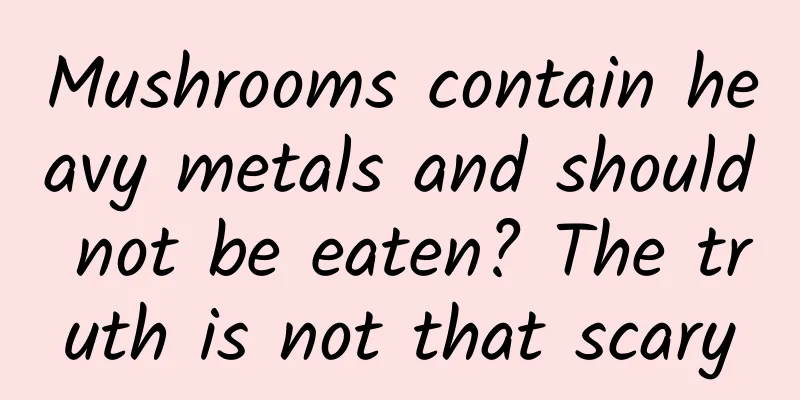Mushrooms contain heavy metals and should not be eaten? The truth is not that scary

|
"Mushrooms contain heavy metals and cannot be eaten." There are videos online saying that although mushrooms are delicious, they have a strong ability to accumulate heavy metals. The human body has no ability to eliminate heavy metals, which can cause renal tubular necrosis over time, so the conclusion is: mushrooms contain heavy metals and cannot be eaten. Rumor analysis: Not true. Mushrooms do have the ability to accumulate heavy metals, but this does not mean that all the mushrooms we eat have excessive heavy metals. Whether the heavy metal content of mushrooms exceeds the standard is related to whether the culture medium of the mushrooms contains a large amount of heavy metals; the type of mushrooms will also affect their ability to accumulate heavy metals. The mushrooms we eat are basically cultivated artificially, and usually do not have the problem of excessive heavy metals. Mushrooms are rich in heavy metals and cannot be eaten? Every summer, mushrooms almost always become the focus of the food world. If you don’t eat some mushrooms in summer, you always feel that something is missing. However, there are rumors that mushrooms have a strong ability to accumulate heavy metals. If you eat too much, heavy metals will accumulate in the body, which is harmful to health. First of all, mushrooms do have the ability to enrich heavy metals, and this ability far exceeds that of green plants and animal foods, especially the adsorption of toxic metals such as lead, arsenic, cadmium, and mercury. Many polluted areas will also use mushrooms with strong adsorption capacity to repair heavy metal-contaminated soil, mainly from two aspects: biological action and adsorption. From the perspective of plant cell physiology, the main physiological steps of edible fungi adsorbing heavy metals include: extracellular accumulation, cell membrane surface adsorption, and intracytoplasmic accumulation, among which extracellular accumulation is limited to living biological cells. 1. Biological effects When heavy metal elements enter the fungal cytoplasm, their macromolecular active groups combine with heavy metal ions to form insoluble substances or precipitates, or special enzymes are produced in the cytoplasm to reduce heavy metals, and their form is converted into an adsorbable state, so that heavy metals are accumulated or adsorbed into the cytoplasm of edible fungi. 2. Adsorption The hyphae of edible fungi absorb heavy metals in the soil, pass through the plasma membrane by passive transport, and form inorganic precipitation in the hyphae cells. The species, different parts, and cultivation methods of mushrooms will affect their enrichment of heavy metals. Among wild mushrooms, boletus has a strong ability to enrich heavy metals; the content of most heavy metals in the cap (umbrella) or gills is significantly higher than that in the stipe, and the lead content in the stipe of Agaricus bisporus is significantly higher than that in the cap and gills, while the cadmium content is still significantly lower than that in the cap and gills. However, we don’t need to worry too much about this. Most of the mushrooms we buy from the market through formal channels are artificially cultivated, and usually there is no excessive heavy metal content. Copyrighted stock images, no reproduction is authorized According to the provisions of the National Food Safety Standard Limits of Contaminants in Food GB 2762-2017, my country stipulates that the limit values of heavy metals in edible fungi are: 1.0 mg/kg for metallic lead, 0.5 mg/kg for total arsenic, and 0.1 mg/kg for metallic mercury. The limit values for metallic cadmium in fresh edible fungi (except shiitake mushrooms and Agaricus blazei) are 0.2 mg/kg, and 0.5 mg/kg for shiitake mushrooms. Up to now, many researchers have conducted tests on the heavy metal content of commercially available edible fungi, and most of them were found to be good. In order to understand the level of heavy metals in the dried edible fungi sold in Anhui Province, researchers have sampled and tested dried shiitake mushrooms, dried black fungus, and white fungus in supermarkets, food stores, and farmers' markets in six areas of Hefei, Anqing, Chizhou, Bozhou, Fuyang, and Huaibei in Anhui Province, with a total of 50 samples. Although the detection rate of heavy metals in the 50 dried edible fungi was 100%, the heavy metal content was generally at a low level, the quality and safety were good, and it was relatively safe to eat. Researchers collected 5 types of common fresh edible fungi sold in large supermarket chains and farmers' markets in Beijing, including shiitake mushrooms, oyster mushrooms, flower mushrooms, enoki mushrooms, and king oyster mushrooms. A total of 42 samples were collected and tested for heavy metal content. The results showed that although the content of various heavy metals in shiitake mushrooms was relatively high, it was still within the safe range. The content of arsenic, cadmium, lead, and mercury in all samples did not exceed the national standard limit requirements, and the risk of ingesting heavy metals through the dietary route was low. Others have determined the content of five heavy metals, lead, arsenic, mercury, cadmium, and chromium, in five cultivated edible fungi in Guizhou Province. 336 batches of fresh edible fungi were collected from 62 edible fungi-growing enterprises in Qianxinan Prefecture, Zunyi City, and Bijie City, Guizhou Province, including 135 batches of shiitake mushrooms, 43 batches of oyster mushrooms, 37 batches of fungus, 59 batches of morels, and 62 batches of bamboo fungi. The results showed that the edible fungi in Guizhou Province were generally at a safe level, and the heavy metal content in most edible fungi was lower than the safety limit value in the national standard, but the cadmium pollution in morels was relatively high. The dietary intake risk of heavy metals in shiitake mushrooms, oyster mushrooms, and fungus was relatively low; there was a certain risk of dietary intake of heavy metals in morels and bamboo fungi, and they could be eaten less at ordinary times. Copyrighted stock images, no reproduction is authorized In other words, although mushrooms have a strong ability to accumulate heavy metals, this does not mean that they are rich in heavy metals, nor does it mean that the heavy metal content of mushrooms will definitely exceed the standard. Usually, we don’t eat mushrooms as a staple food in large quantities, but only occasionally as a delicious dish, so there is no need to worry too much. You can avoid choosing wild mushrooms and try to buy guaranteed artificially cultivated mushrooms through formal channels. What should you pay attention to when eating mushrooms? Although mushrooms are delicious, you can't just eat them. You need to know these two things before eating them. 1. Be careful of poisonous mushrooms Among the mushrooms that have been identified in my country, there are nearly 300 edible species, about 100 poisonous species, and at least 10 species that can cause death. There is no simple and reliable way to identify poisonous mushrooms at a glance, so for safety reasons, it is best not to eat mushrooms that we have never eaten before, and do not pick mushrooms that are too good to look at, let alone reach out to touch them out of curiosity. Most poisonous mushrooms can cause symptoms such as liver and kidney damage, nerve damage, gastroenteritis, dermatitis, and severe cases can cause death. Even if some mushrooms are edible, they must be thoroughly cooked, otherwise they may cause poisoning, such as porcini. 2. It is recommended to blanch the water first Mushrooms not only have an earthy smell, but they are also easy to harbor dirt. Washing and blanching can better avoid these problems and reduce microbial risks. In summary: Although mushrooms are prone to heavy metal accumulation, as long as we eat less wild mushrooms and try to buy guaranteed artificially cultivated mushrooms through formal channels, we don’t have to worry too much. At the same time, the most important thing is: don’t pick or eat mushrooms you don’t recognize, be careful of poisoning! Looking in the mirror of rumors Overgeneralizing the ability of mushrooms to accumulate heavy metals to mean that all mushrooms contain dangerous levels of heavy metals ignores the variables of the mushroom growing environment, such as the fact that cultivated mushrooms are typically grown in a controlled environment, reducing the risk of heavy metal contamination. When we face rumors of overgeneralization and ignoring variables, we must learn to make objective judgments and try to cross-verify information through multiple channels to avoid relying on a single source. Author: Xue Qingxin, registered nutritionist Review丨Zhang Yu, researcher/PhD, Chinese Center for Disease Control and Prevention, national health science expert |
<<: Millennium Populus euphratica, is it really 1,000 years old?
>>: First of its kind in my country! This technology successfully crosses the "Death Valley" →
Recommend
How do the ivy that can be seen everywhere under the viaduct "climb" up there?
Walking on the city streets lined with reinforced...
Five elements and methods of operating Alibaba events!
I have worked in almost all types of operations a...
Android 5.0 Lollipop source code released
[[122293]] Google uploaded the latest Android 5.0...
Uncovering the Universe's Invisible Messengers: Groundbreaking Discovery from IceCube Neutrino Observatory
Your browser does not support the video tag Autho...
Microsoft: 7 reasons why you will love Win10
Although some major companies are missing from th...
Osteoarthritis is not just a problem for the elderly, these groups of people should also be careful!
Osteoarthritis: a growing global disease burden O...
The starting gun for VR has been fired, are you still waiting and watching?
Virtual reality and augmented reality are high-te...
National Child Vaccination Day: Here’s what parents should know
Today is the 36th "National Children's V...
AMIRO Small Black Mirror VS Tmall Genie QUEEN Beauty Mirror: Which one is the "magic mirror" that makes you prettier than Snow White?
Loving beauty has always been a girl’s nature. Wi...
The "king of acting" in the animal world: the destructive tree-boring pest that "dies" with just one touch - the Yanggan elephant
Among the many types of wood in the world, the mo...
How to keep her energy job? She looks for oil in shale cracks
Your browser does not support the video tag Oil i...
Are the penalties for violating regulations at Douyin stores severe?
There are indeed many sellers on Douyin Stores wh...
Many people don’t know all these things about wine!
Autumn is the season for grape harvest. Grapes ca...
Here is a case analysis of a blind date information flow advertisement, so that you won’t be lonely on Valentine’s Day!
Friends often ask, what are the differences in th...
AI fortune-telling becomes a new favorite, "cyber palm reading" is really not metaphysics! 丨 Interesting Science of the Week
01 Supersolid matter achieves ultra-low temperatu...









